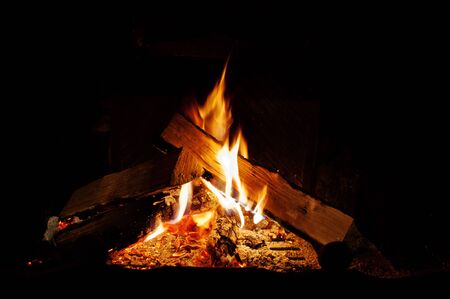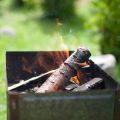1. Site Selection and Preparation
How to Choose a Safe Location
Picking the right spot for your fire ring is the first step to a safe and enjoyable campfire. Look for a flat, open area that’s at least 15 feet away from tents, trees, shrubs, and anything else that can catch fire easily. Avoid spots under low-hanging branches or near dry grass. If you’re in a campground, use existing fire rings whenever possible to minimize your impact on nature.
| Do | Dont |
|---|---|
| Pick flat, bare soil or gravel | Build fires on grassy or peaty areas |
| Stay away from overhanging branches | Set up close to bushes or tents |
| Check wind direction and strength | Build in windy spots or on slopes |
| Use existing fire rings when available | Create multiple new fire sites |
Responsibly Clearing the Area
Once you’ve picked your site, clear a circle about 10 feet wide around where you’ll build your fire ring. Remove any leaves, twigs, pine needles, and other flammable debris down to bare earth. Stack rocks in a tight circle to form the ring—this helps contain the flames and heat. Always keep a bucket of water and a shovel nearby for safety.
Quick Checklist for Fire Ring Prep:
- Clear ground down to dirt within a 5-foot radius of the fire ring
- Remove all flammable materials (leaves, sticks, pine needles)
- Build a sturdy rock circle as your fire ring barrier
- Keep water and a shovel within arm’s reach at all times
- If it’s too dry or windy, skip the fire entirely for safety
Taking these steps ensures your campfire is safe for everyone—and gentle on nature.
2. Gathering Materials and Tools
Before you start building your fire ring, it’s important to gather all the right materials and tools. Choosing natural, local, and eco-friendly options helps protect the environment while keeping your campfire safe and efficient.
Essential Items for Your Fire Ring
| Item | Description | Eco-Friendly Tip |
|---|---|---|
| Natural Stones or Rocks | Form the main barrier for your fire ring. Look for stones that are dry and free from cracks. | Use rocks found around your campsite instead of bringing them in from elsewhere. |
| Shovel or Trowel | Helps clear away grass and dig a shallow pit for your fire ring base. | Borrow a tool instead of buying new if you’re camping with friends. |
| Buckets of Water or Sand | Keep nearby for fire safety and quick extinguishing. | Refill from natural water sources when possible, but only if allowed by local guidelines. |
| Work Gloves | Protects your hands while moving stones and digging. | Choose gloves made from natural fibers or reused materials. |
| Tape Measure or Stick (Optional) | Keeps your fire ring size consistent and manageable (about 3 feet across is ideal). | A simple stick works just as well—no need for extra gear. |
Tips for Eco-Conscious Choices
- Avoid collecting stones from riverbeds or fragile habitats.
- Reuse existing fire rings if available instead of building new ones.
- Stick to minimal tools—less gear means a lighter environmental footprint.
- Always check local regulations about gathering materials at your campsite.
Your Next Step: Prepare the Site Thoughtfully
With these materials and tips in mind, you’re ready to move on to preparing the site for a safe and beautiful fire ring that respects nature and keeps everyone at camp comfortable.
![]()
3. Building the Fire Ring Structure
Step-by-Step Guide to Arranging Stones
Building a sturdy fire ring is essential for both safety and efficiency when camping in the US outdoors. Follow these easy steps to create a fire pit that feels natural and blends with the landscape.
Materials Youll Need
| Material | Description |
|---|---|
| Rocks/Stones | Flat, non-porous stones about the size of your hand |
| Shovel or Trowel | For leveling ground and digging a shallow pit |
| Gloves | Protects hands from sharp edges and dirt |
Step 1: Choose Your Spot
Select a flat area at least 15 feet from tents, trees, and brush. Make sure you follow local campground rules before starting.
Step 2: Clear and Level the Ground
Remove all grass, leaves, and twigs. Use your shovel or trowel to level the ground so your stones will sit evenly.
Step 3: Dig a Shallow Pit
Dig a shallow hole about 2-3 inches deep and 2-3 feet wide. This helps contain embers and keeps your fire steady.
Step 4: Arrange the First Layer of Stones
Create a circle with your largest, flattest stones. Place them snugly together, forming the base ring. Make sure they are stable by pressing each into the soil gently.
Stone Arrangement Tips
| Tip | Why It Matters |
|---|---|
| Use Flat Stones for Base | Keeps fire ring stable and less likely to tip over |
| Tight Placement | Prevents heat from escaping between gaps and holds shape better |
| Avoid River Rocks (if possible) | Some may contain moisture and can crack or explode when heated |
Step 5: Build Up Additional Layers
Add one or two more layers of stones on top of the base ring, staggering seams like you’re building with bricks. This increases stability and helps reflect heat back into the center.
Step 6: Double-Check Stability and Safety Gap
Walk around your fire ring, making sure all stones are solid and there are no large gaps. Leave a small opening if you want better airflow—just make sure it doesn’t face prevailing winds.
4. Fire Safety and Leave No Trace Principles
Staying Safe Around Your Campfire
Building a fire ring is about more than just warmth and cooking—it’s also about safety. A well-constructed fire pit helps keep your campfire under control, but you still need to follow essential fire safety steps. Here’s how you can stay safe and protect the outdoors.
Practical Steps to Minimize Wildfire Risk
| Step | How To Do It | Why It Matters |
|---|---|---|
| Choose a Safe Spot | Pick a site at least 15 feet from tents, trees, shrubs, and anything that can burn. | Keeps fire away from flammable materials. |
| Clear the Area | Remove leaves, sticks, and dry grass in a 10-foot circle around your fire ring. | Prevents stray embers from starting wildfires. |
| Keep Water Nearby | Always have a bucket of water or sand within arm’s reach. | You can quickly douse flames if they get out of hand. |
| Build Small Fires | Use only as much wood as you need, keeping flames low and manageable. | Easier to control; reduces risk of spreading. |
| Never Leave Unattended | Stay with your campfire until it is completely out—no exceptions. | A moment’s distraction can lead to disaster. |
| Drown, Stir, and Feel Ashes | Saturate ashes with water, stir them, then check with the back of your hand for heat before leaving. | Makes sure everything is fully extinguished and safe to leave behind. |
Leave No Trace: Protecting Nature for Everyone
- Use Existing Fire Rings: If there’s already a fire ring at your campsite, use it instead of making a new one. This limits your impact on the land.
- Pile Stones Carefully: When building your own ring, use rocks from the area—don’t bring in new ones or take any home. When you leave, scatter unused stones to return the spot to its natural state.
- Avoid Burning Trash: Only burn clean wood. Never put plastics, cans, or food scraps in the fire—they pollute air and soil and harm wildlife.
- Pack Out What You Pack In: Take all your trash with you when you leave. Leave your campsite cleaner than you found it.
- No Trace Left Behind: After dismantling your fire ring, cover the spot with local soil or leaf litter so future campers see only nature—not signs of human activity.
5. Enjoying and Maintaining Your Fire Pit
Mindful Use of Your Fire Ring
After building your fire ring, it’s time to enjoy the warmth and ambiance it brings to your camp. Remember, a safe campfire experience starts with being aware and respectful of your surroundings.
Fire Ring Safety Tips
| Do | Dont |
|---|---|
| Keep water or a shovel nearby | Leave fire unattended |
| Burn only local wood | Use flammable liquids |
| Keep the fire small and manageable | Build a fire during windy conditions |
| Fully extinguish before leaving or sleeping | Bury live embers under dirt or sand |
Easy Maintenance for Every Camper
Your fire ring will last longer and stay safer with simple, regular care. Here’s how you can keep it in top shape:
Weekly Quick-Check List
- Remove Ashes: Scoop out cold ashes to prevent buildup.
- Inspect Rocks: Make sure no stones are cracked or loose.
- Clear Debris: Keep leaves and sticks away from the edge.
- Smooth the Perimeter: Ensure the ring is still round and stable.
- Check for Trash: Leave no trace—pack out what you bring in.
Sustainable Campfire Practices
Embrace natural harmony by using only fallen branches and deadwood. Avoid burning plastics or trash, as they harm both air quality and local wildlife. When youre done, make sure your fire is “cold out”—ashes should be cool to the touch.
The Simple Joy of Gathering Around the Fire
Your well-built fire ring sets the scene for stories, songs, and quiet moments under the stars. Treat it with care, use it thoughtfully, and you’ll create lasting memories while keeping nature beautiful for everyone.


